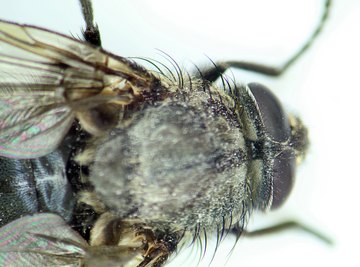
Understanding what happens to a body after death is helpful to crime scene investigators in determining when the death occurred. In addition to the actual physical conditions present in the corpse, researchers study the kinds and life stages of insects present in a decaying body to help pinpoint the time of death. There are five decomposition stages. Many factors influence how quickly the decomposition stages progress, such as temperature, moisture and whether the body is exposed or buried. Decomposition is faster at high temperatures, if the body has traumatic injuries, or if the remains are exposed.
The Beginning Two Stages
As soon as death occurs, enzymes within dead body cells begin to break down tissues, a process called autolysis, and bacteria within the digestive tract begin to digest the intestines. During the first stage, called the fresh stage, usually lasting a day or two, the body doesn't change much outwardly, but chemicals released during cellular death begin to attract flies. The second stage begins when the body begins to swell and is called putrefaction or the bloated stage. Internal bacterial decomposition due to intestinal bacteria entering the rest of the body produces gases that inflate the body. The strong smells associated with the gases attract egg-laying flies, mostly blowflies.
The Third Stage
As the buildup of gases increases pressure within the dead body, the fluids within it are forced outside, usually through body openings such as the nose or mouth or through breaks in the abdominal wall. Fluid release marks the beginning of the third stage, called the purging or decay stage. Fluid eventually can leak through any soft tissues as decomposition progresses. Larval blowflies, flesh flies and house flies, all called maggots, are abundant in this stage due to the semiliquid environment. There is no definite event, such as bloating or purging, that separates stage three from the later, drier stages of decomposition.
The Fourth Stage
During the fourth stage, called post-decay or dry decay, most of the body's soft tissues have decomposed, leaving bones, hair, cartilage and an accumulation of wet, sticky material called byproducts of decay. Different insects are present, including beetles and small flies such as cheese flies and coffin flies that prefer a drier environment. Both larval and adult beetles have chewing mouthparts that allow breakdown of drier, tougher tissue such as ligaments, cartilage and other dry tissues.
The Fifth Stage
The remains stage, or skeletonization, occurs when the byproducts of decay have dried and most tissues other than the bones are gone. The insects that gradually remove the driest tissues are beetles such as rove beetles, dermestid beetles and carrion beetles. Flies such as humpback flies, skipper flies and dung flies can also occur in late-stage remains. Mites and moth larvae digest hair.
References
- Simon Fraser University: Museum of Archaeology & Ethnology: Investigating Forensics: Forensic Entomology or the Use of Insects in Death Investigations
- Forensic Archaeology: Decomposition
- PLOS One: The Living Dead: Bacterial Community Structure of a Cadaver at the Onset and End of the Bloat Stage of Decomposition
- Natural History Museum: On Maggots and Murders: Forensic Entomology
- Explore Forensics: The Rate of Decay in a Corpse
- Journal of Forensic Dental Sciences: The Use of Insects in Forensic Investigations: An Overview On the Scope of Forensic Entomology
About the Author
Carolyn Csanyi began writing in 1973, specializing in topics related to plants, insects and southwestern ecology. Her work has appeared in the "American Midland Naturalist" and Greenwood Press. Csanyi holds a Doctor of Philosophy in biology from the University of Wisconsin at Madison.
Photo Credits
Jupiterimages/Photos.com/Getty Images
